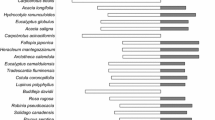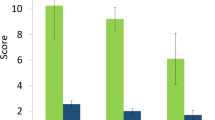Abstract
The introduction and spread of invasive alien species is a serious threat to ecosystem structures, functions and services worldwide. At enormous cost and effort, attempts are being made to stop and reduce the ongoing appearance of alien species in ecosystems to protect the regional and native biodiversity. Still, management of invasive alien species in particular is often not successful. One reason is a lack of robust toolkits for the management of these species. Guidance on measures which are efficient and effective and which have no negative impact on the environment and human health is urgently needed for decision-making. As a result of an expert workshop, we present a set of three evaluation criteria: effectiveness, ecological impact, and impact on human health. These criteria allow an evaluation of management measures for the prevention, eradication, control and utilisation/disposal of invasive alien species for nature conservation purposes. We applied this evaluation system for 168 invasive and potentially invasive alien species of five taxonomic groups (fungi, non-vascular plants, vascular plants, invertebrates and vertebrates) involving 3619 different management measures. The evaluation of management measures and resulting recommendations for their application are a necessary basis for appropriate, ecologically necessary and professionally sound management. This new approach provides an essential framework for future decisions on management measures, for example in accordance with the provisions of the new Regulation (EU) No 1143/2014 of the European Parliament and of the Council of 22 October 2014 on the prevention and management of the introduction and spread of invasive alien species.





Similar content being viewed by others
References
Blackburn TM, Essl F, Evans T, Hulme PE, Jeschke JM, Kühn I, Kumschick S, Marková Z, Mrugała A, Nentwig W, Pergl J, Pyšek P, Rabitsch W, Ricciardi A, Richardson DM, Sendek A, Vilà M, Wilson JRU, Winter M, Genovesi P, Bacher S (2014) A unified classification of alien species based on the magnitude of their environmental impacts. PLoS Biol 12(5):e1001850. doi:10.1371/journal.pbio.1001850
Cardoso AC, Katsanevakis S, D’Amico F, Deriu I (2014) A European early warning and rapid response system of invasive alien species. In Uludag A, Yazlik A, Jabran K, Türkseven S, Starfinger U (Eds.): Neobiota 2014. 8th International Conference on Biological Invasions. From understanding to action. Antalya, Turkey, 03–08 Nov 2014. Proceedings, p 68
CBD (Convention on Biological Diversity) (2000) Global strategy on invasive alien species. Convention on biological diversity. UNEP/CBD/SBSTTA/6/INF/9: 1–52
CBD (Convention on Biological Diversity) (2002) Alien species that threaten ecosystems, habitats or species. COP VI/23. http://www.cbd.int/decisions/
COM (Commission of the European Communities) (2008) Towards an EU strategy on invasive species. COM (2008) 789 final. SEC (2008) 2887 et SEC (2008) 2886
Davis MA (2009) Invasion biology. Oxford University Press, Oxford
Epanchin-Niell RS, Hastings A (2010) Controlling established invaders: integrating economics and spread dynamics to determine optimal management. Ecol Lett 13:528–541. doi:10.1111/j.1461-0248.2010.01440.x
Essl F, Nehring S, Klingenstein F, Milasowszky N, Nowack C, Rabitsch W (2011) Review of risk assessment systems of IAS in Europe and introducing the German–Austrian black list information system (GABLIS). J Nat Conserv 19:339–350. doi:10.1016/j.jnc.2011.08.005
Gardener MR, Atkinson R, Rentería JL (2010) Eradications and people: lessons from the plant eradication program in Galapagos. Restor Ecol 18(1):20–29. doi:10.1111/j.1526-100X.2009.00614.x
Gasnier C, Dumont C, Benachour N, Clair E, Chagnon M-C, Séralini G-E (2009) Glyphosate-based herbicides are toxic and endocrine disruptors in human cell lines. Toxicol 262(3):184–191. doi:10.1016/j.tox.2009.06.006
Genovesi P, Shine C (2004) European strategy on invasive alien species: convention on the conservation of european wildlife and habitats (Bern Convention). Nature and environment 137. Council of Europe Publishing, Strasbourg
Graham J, Simpson A, Crall A, Jarnevich C, Newman G, Stohlgren TJ (2008) Vision of a cyberinfrastructure for nonnative, invasive species management. Bioscience 58(3):263–268. doi:10.1641/B580312
Guillera-Arroita G, Hauser CE, McCarthy MA (2014) Optimal surveillance strategy for invasive species management when surveys stop after detection. Ecol Evol 4(10):1751–1760. doi:10.1002/ece3.1056
Hobbs RJ, Humphries SE (1995) An integrated approach to the ecology and management of plant invasions. Conserv Biol 9(4):761–770
Hulme PE (2006) Beyond control: wider implications for the management of biological invasions. J Appl Ecol 43(5):835–847. doi:10.1111/j.1365-2664.2006.01227.x
Hulme PE (2009) Trade, transport and trouble: managing invasive species pathways in an era of globalization. J Appl Ecol 46(1):10–18. doi:10.1111/j.1365-2664.2008.01600.x
Hussner A, Nehring S, Hilt S (2014) From first reports to successful control: a plea for improved management of alien aquatic plant species in Germany. Hydrobiologia 737(1):321–331. doi:10.1007/s10750-013-1757-5
Kettenring KM, Reinhardt Adams C (2011) Lessons learned from invasive plant control experiments: a systematic review and meta-analysis. J Appl Ecol 48(4):970–979. doi:10.1111/j.1365-2664.2011.01979.x
Kumschick S, Bacher S, Dawson W, Heikkilä J, Sendek A, Pluess T, Robinson T, Kühn I (2012) A conceptual framework for prioritization of invasive alien species for management according to their impact. NeoBiota 15:69–100. doi:10.3897/neobiota.15.3323
Lahoz-Monfort JJ, Guillera-Arroita G, Hauser CE (2014) From planning to implementation: explaining connections between adaptive management and population models. Front Ecol Evol 2:60. doi:10.3389/fevo.2014.00060
Le Roux J, Wieczorek AM (2009) Molecular systematics and population genetics of biological invasions: towards a better understanding of invasive species management. Ann Appl Biol 154(1):1–17. doi:10.1111/j.1744-7348.2008.00280
Mehta SV, Haight RG, Homans FR, Polasky S, Venette RC (2007) Optimal detection and control strategies for invasive species management. Ecol Econ 61(2):237–245. doi:10.1016/j.ecolecon.2006.10.024
Nehring S, Kowarik I, Rabitsch W, Essl F (eds) (2013): Naturschutzfachliche Invasivitätsbewertungen für in Deutschland wild lebende gebietsfremde Gefäßpflanzen. BfN-Skripten vol 352
Nehring S, Rabitsch W, Kowarik I, Essl F (eds) (2015): Naturschutzfachliche Invasivitätsbewertungen für in Deutschland wild lebende gebietsfremde Wirbeltiere. BfN-Skripten vol 409
Pyšek P, Richardson DM (2010) Invasive species, environmental change and management, and health. Annu Rev Environ Resour 35:25–55. doi:10.1146/annurev-environ-033009-095548
Pyšek P, Jarošík V, Hulme PE, Pergl J, Hejda M, Schaffner U, Vilà M (2012) A global assessment of invasive plant impacts on resident species, communities and ecosystems: the interaction of impact measures, invading species’ traits and environment. Glob Chang Biol 18(5):1725–1737. doi:10.1111/j.1365-2486.2011.02636.x
Rejmánek M, Pitcairn MJ (2002) When is eradication of exotic pest plants a realistic goal? IN: Veitch CR, Clout MN (eds) Turning the tide: the eradication of invasive species. Occasional Paper of the IUCN Species Survival Commission No 27
Relyea RA, Jones DK (2009) The toxicity of Roundup Original Max® to 13 species of larval amphibians. Environ Toxicol Chem 28(9):2004–2008. doi:10.1897/09-021.1
Ricciardi A, Hoopes MF, Marchetti MP, Lockwood JL (2013) Progress toward understanding the ecological impacts of nonnative species. Ecol Monogr 83(3):263–282. doi:10.1890/13-0183
Richard S, Moslemi S, Sipahutar H, Benachour N, Séralini G-E (2005) Differential effects of glyphosate and roundup on human placental cells and aromatase. Environ Health Perspect 113(6):716–720
Ruiz G, Carlton JT (2003) Invasive species: vectors and management strategies. Island Press, Washington, DC
Scheibner C, Roth M, Nehring S, Schmiedel D, Wilhelm E-G, Winter S (2015): Management-Handbuch zum Umgang mit gebietsfremden Arten in Deutschland. Wirbellose Tiere und Wirbeltiere. Naturschutz und Biologische Vielfalt 141, Band 2. Bundesamt für Naturschutz, Bonn
Schmiedel D, Wilhelm E-G, Nehring S, Scheibner C, Roth M, Winter S (2015) Management-Handbuch zum Umgang mit gebietsfremden Arten in Deutschland. Pilze, Niedere Pflanzen und Gefäßpflanzen. Naturschutz und Biologische Vielfalt 141, Band 1. Bundesamt für Naturschutz, Bonn
Schmiedel D, Wilhelm E-G, Scheibner C, Roth M, Nehring S, Winter S (2016, in press) Aktueller Status von Managementmaßnahmen gegen gebietsfremde Arten in Deutschland: Eine bundesweite Umfrage. Nat Landsch
Simberloff D (2009) We can eliminate invasions or live with them. Biol Invasions 11(1):149–157. doi:10.1007/s10530-008-9317-z
Simberloff D, Parker IM, Windle PN (2005) Introduced species policy, management, and future research needs. Front Ecol Environ 3(1):12–20
van Wilgen BW, Forsyth GG, Le Maitre DC, Wannenburgh A, Kotzé JD, van den Berg E, Henderson L (2012) An assessment of the effectiveness of a large, national-scale invasive alien plant control strategy in South Africa. Biol Conserv 148(1):28–38. doi:10.1016/j.biocon.2011.12.035
Wilson JR, Ivey P, Manyama P, Nänni I (2013) A new national unit for invasive species detection, assessment and eradication planning. S Afr J Sci 109(5/6):1–13. doi:10.1590/sajs.2013/20120111
Wittenberg R, Cock MJ (2001) Invasive alien species: a toolkit of best prevention and management practices. Global Invasive Species Programme, CABI
Acknowledgments
We thank all practitioners and members of our survey for sharing their knowledge and experience with us. We thank three anonymous reviewers for their comments to improve the manuscript. And we thank Stuart W. Blackman who improved our English writing. This project was supported by the German Ministry for the Environment, Nature Conservation, Building and Nuclear Safety as Research and Development Project number FKZ 3513 86 0200.
Author information
Authors and Affiliations
Corresponding author
Additional information
Communicated by Dirk Sven Schmeller.
Electronic supplementary material
Below is the link to the electronic supplementary material.
Rights and permissions
About this article
Cite this article
Schmiedel, D., Wilhelm, EG., Roth, M. et al. Evaluation system for management measures of invasive alien species. Biodivers Conserv 25, 357–374 (2016). https://doi.org/10.1007/s10531-016-1054-5
Received:
Revised:
Accepted:
Published:
Issue Date:
DOI: https://doi.org/10.1007/s10531-016-1054-5




